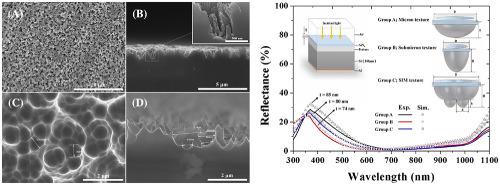当前位置:
X-MOL 学术
›
Prog. Photovoltaics
›
论文详情
Our official English website, www.x-mol.net, welcomes your feedback! (Note: you will need to create a separate account there.)
Forming submicron in micron texture on the diamond‐wire‐sawn mc‐Si wafer by introducing artificial defects
Progress in Photovoltaics ( IF 6.7 ) Pub Date : 2020-03-20 , DOI: 10.1002/pip.3271 Chengkun Wu 1 , Shuai Zou 1, 2 , Jingyan Zhu 1 , Xiaoya Ye 2 , Jianming Ding 1 , Hua Sun 1 , Xusheng Wang 2 , Guoqiang Xing 2 , Xiaohong Zhang 1 , Xiaodong Su 1
Progress in Photovoltaics ( IF 6.7 ) Pub Date : 2020-03-20 , DOI: 10.1002/pip.3271 Chengkun Wu 1 , Shuai Zou 1, 2 , Jingyan Zhu 1 , Xiaoya Ye 2 , Jianming Ding 1 , Hua Sun 1 , Xusheng Wang 2 , Guoqiang Xing 2 , Xiaohong Zhang 1 , Xiaodong Su 1
Affiliation

|
Based on a traditional acid etch system (i.e., HNO3/HF), a complex texture comprising microscale and submicroscale structures was produced on the surface of a diamond‐wire‐sawn (DWS) multicrystalline Si (mc‐Si) wafer, upon whose surface it is typically difficult to form an effective texture for suppressing the reflection of incident light. Immersing the as‐cut wafer into an HF/HNO3/AgNO3 solution introduced a large number of artificial defects onto the wafer surface. A subsequent HNO3/HF etch induced a micron texture expanded from the original DWS‐induced damage as well as a submicron texture converted from the artificial defects. The multiscale textured DWS exhibited a reflectivity of ~19%, which is much lower than the reflectivity after only an HNO3/HF etch (~28%). Therefore, the solar cell performance was improved owing primarily to improved optical antireflection and surface passivation. The method is simple and can be easily scaled up into the in‐line texture process.
中文翻译:

通过引入人工缺陷在金刚石线锯片mc-Si晶圆上形成微米级纹理的亚微米级
基于传统的酸蚀系统(即HNO 3 / HF),在金刚石线锯(DWS)多晶硅(mc-Si)晶片的表面上产生了包含微米级和亚微米级结构的复杂纹理。在表面上,通常难以形成有效的纹理来抑制入射光的反射。将切割后的晶片浸入HF / HNO 3 / AgNO 3溶液中会在晶片表面上引入大量的人工缺陷。随后的HNO 3/ HF蚀刻产生了从原始DWS引起的损伤扩展而来的微米织构,以及从人工缺陷转换而来的亚微米织构。多尺度纹理化DWS的反射率约为19%,远低于仅HNO 3 / HF蚀刻后的反射率(约为28%)。因此,主要由于改善的光学减反射和表面钝化而改善了太阳能电池的性能。该方法很简单,可以轻松地扩展到在线纹理处理中。
更新日期:2020-03-20
中文翻译:

通过引入人工缺陷在金刚石线锯片mc-Si晶圆上形成微米级纹理的亚微米级
基于传统的酸蚀系统(即HNO 3 / HF),在金刚石线锯(DWS)多晶硅(mc-Si)晶片的表面上产生了包含微米级和亚微米级结构的复杂纹理。在表面上,通常难以形成有效的纹理来抑制入射光的反射。将切割后的晶片浸入HF / HNO 3 / AgNO 3溶液中会在晶片表面上引入大量的人工缺陷。随后的HNO 3/ HF蚀刻产生了从原始DWS引起的损伤扩展而来的微米织构,以及从人工缺陷转换而来的亚微米织构。多尺度纹理化DWS的反射率约为19%,远低于仅HNO 3 / HF蚀刻后的反射率(约为28%)。因此,主要由于改善的光学减反射和表面钝化而改善了太阳能电池的性能。该方法很简单,可以轻松地扩展到在线纹理处理中。

























 京公网安备 11010802027423号
京公网安备 11010802027423号